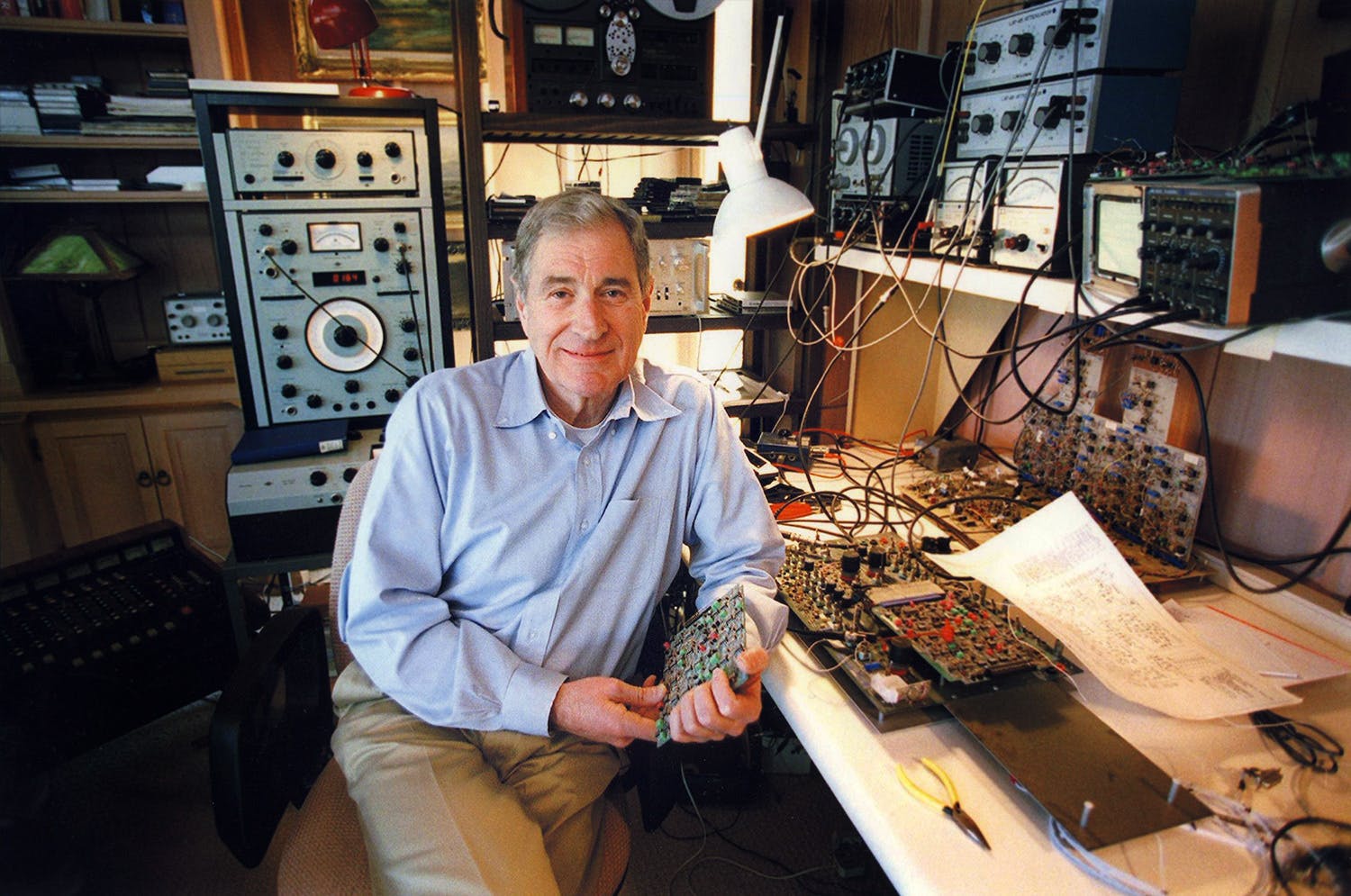Digital exhibit on Ray Dolby ('57)

Billions of people have likely seen the name "Dolby" at the movies in relation to Dolby Stereo, or on the audio components of cassette recorders, video games, or televisions, without thinking of the person behind the technology.
Ray Dolby (1933-2013), American engineer and inventor, transformed the music recording and film industries by improving sound quality through a noise-reduction system that removed tape noise or "hiss" without distorting the original signal. He founded Dolby Laboratories in 1965. Since then, Dolby technologies have become essential tools in the creative process for recording artists and filmmakers.
The Ray Dolby Papers were donated to Stanford’s Silicon Valley Archives in October 2023 by his widow, Dagmar Dolby, and processed in spring of 2024. Now the digital exhibit, “Ray Dolby: Inventor at the Intersection of Art & Technology,” draws from those papers to convey a sense of Ray Dolby the person.
Short articles showcase lesser-known aspects of Ray Dolby’s life using digitized material from the collection, including schoolwork from his days at Sequoia Union High School in Redwood City and documents from his undergraduate days at Stanford (’57). Of particular interest are the high school compositions Dolby wrote about his part-time job at Ampex Corporation, where Dolby eventually invented most of the electronics behind the world’s first practical video tape recorder for broadcast television use (before the age of 20). Ray Dolby studied Electrical Engineering at Stanford from 1955-57, after already completing a year at San Jose State College and serving in the Army for two. Dolby held onto his Stanford coursework, saving several papers from a required writing course, English 2B, which earned some stinging comments from his professor (these are well worth a read!)
Upon graduating from Stanford, Ray Dolby was offered a Marshall Scholarship to study physics at Cambridge University’s Cavendish Laboratory. His research on long wavelength X-ray microanalysis proved useful to theoretical and practical developments in materials science, while the circuitry he invented to enhance the capacities of Cavendish Lab’s light element x-ray analyzer earned him a consulting role with the UK Atomic Energy Authority.
While his technical curiosity led Dolby to science, his passion was music. One of his hobbies at Cambridge was to tape record live performances in such spaces as King’s College Chapel, using his Ampex 600 professional-grade open-reel recorder and high quality mics. Some documents he kept from this period include a copy of UK laws regarding copyright in sound recordings, and a letter from the celebrated British choral conductor Sir David Willcocks giving Dolby his permission to approach Benjamin Britten about recording an upcoming performance of Britten’s Cantate Academica.
One of Ray Dolby’s lesser-known experiences is his involvement with UNESCO in India as a technical advisor from 1963-1965. Dolby was sometimes frustrated by the bureaucracy involved in working for an international organization while simultaneously attempting to help scientific instruments manufacturers across northern India in practical ways, but his time in New Delhi and later Chandigarh gave him opportunities to travel and to record local musicians. Dolby had long been frustrated by the element of hiss that was always an element of magnetic sound recording. While listening to the playback on some of the recordings he made in India, Dolby had a brainstorm, which led to the invention of the Dolby A301 noise reduction system and, with it, Dolby Laboratories.

Dagmar Baumert met Ray Dolby in Cambridge in 1962; they married in 1966. Dagmar took an active part in the early days of Dolby Laboratories in a variety of roles, including as a circuit board wirewoman when their small staff was overwhelmed with orders. Dagmar traveled with Ray all over the world, starting with a visit to India and an overland trip by VW bug back to Europe when his role with UNESCO was completed. Dagmar decided to donate the archive to Stanford because, she said, “It is fitting to have Ray’s papers return to Stanford and remain in the Bay Area where Ray went to high school, college, and where he started his earliest career nearby at Ampex when he became the inventor of the electronics behind the first video tape recorder.”
Ray Dolby passed away in 2013 at the age of 80. He revolutionized the way we experience recorded music and sound. This exhibit offers a glimpse of the person behind the technology that made Dolby a household name.
Acknowledgements
Dolby Media Archivist Rebecca Gordon was hired in April 2024. She processed the collection, conducted background research, created metadata, wrote the text, and designed the exhibit. She looks forward to working with Media Librarian Alison de Geus on putting technical drawings from the Ray Dolby Papers on display in Green Library’s Media Center later in 2025. Special thanks to Henry Lowood in the Silicon Valley Archives, Cathy Aster from Digital Library Systems & Services for enthusiastic training and support, and Chris Hacker, Linda Lam, Nat Chua, Wayne Vanderkuil, Cheryll Go, and Hannah Frost from the Digital Production Group for their expertise and good advice.
For further information
The greater extent of the Ray Dolby papers has not been digitized; these materials are available for viewing and research on site at Stanford University. A guide to the entire processed collection can be found on the Online Archive of California, Dolby (Ray M.) Papers, Finding Aid.
In 2001, Stanford Libraries acquired the Ampex Corporation Records and elements of the Ampex Museum with assistance from Dolby Laboratories. A guide to the Ampex collection can be found on the Online Archive of California, Ampex Corporation Records, Finding Aid.
The Dolby family has demonstrated its fondness for Cambridge University through several philanthropic gifts, including the Dolby Collection at the Cavendish which consists, among other things, of the clarinet Ray Dolby played for Dagmar in his rooms at Pembroke, and the original draft of Ray Dolby’s thesis on Long Wavelength X-Ray Microanalysis.